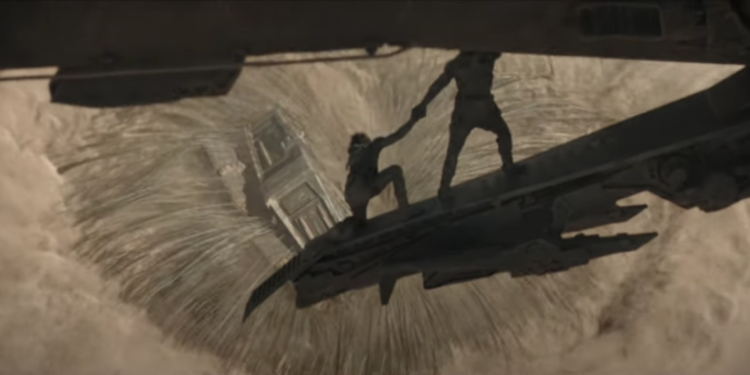If there’s one thing most people know about the world of Dune, aside from it being a desert planet and an inspiration to films like Star Wars and Avatar, it’s the Sandworms. Aside from being one of the coolest pieces of alien design in science fiction, they play a major role in the story, inextricably linked to the arid world of Arrakis. They left such an indelible mark on pop culture, even Fatboy Slim included a reference to them in his song “Weapon of Choice.”
But despite being referenced or borrowed by Beetlejuice, Tremors, and a dozen other properties, the giant creatures do leave questions about why they exist in the narrative. With all of the existential threats the Atreides family faces, they certainly don’t need enormous sand leviathans to add to the danger. But apart from the cool factor, these desert dwellers are a critical part of what makes Dune such a satisfying story to experience.
Dune’s Sandworm Biology Explained

The first questions most people have are how big they are, and how something so immense can survive in such an arid environment. The average fully-grown worm can reach a length of 450 meters, though worms up to 1,000 meters have been sighted at the planet’s poles. To put this in perspective, the Blue Whale, the largest animal on Earth, has a maximum length of about 35 meters. These worms are the size of the Empire State Building or Burj Khalifa, and since worm corpses are rare sightings, it’s believed they can live for millennia.
The comparison to whales is apt, since their primary food source is Sand Plankton. While nowhere as small as plankton on earth, they represent a similar difference in size between them and the gargantuan animals that eat them. While some viewers decried the cloacal appearance of the worms in the 2021 adaptation, this is the most “scientifically sound” concept for how a worm’s mandible would look and function (Dune’s director Denis Villeneuve famously put a lot of effort into making them feel biologically plausible). Even though the worms primarily eat minuscule creatures, they are incredibly sensitive to vibration and can breach the sand quickly to attack any animal moving with a rhythmic motion of footsteps.
As to how they can move through the ground as they do, the book never fully explains, but many biologists have posited theories as to how it might be plausible. The first is that since the worms are segmented like terrestrial annelids (although much larger and armored to protect from the abrasive medium), they expand and contract these segments to push themselves through the ground. While this explains part of the motion, sand is denser than many realize, which is why the 2021 film depicts the worms using fluidation to make the sand easier to traverse. As seen in this clip, vibrations can cause sand to become almost like water. Since worms are sensitive to vibration, it would make sense for them to use subsonic sound to make the sand into a fluid that their segments can then move through.
The Fremen’s Relationship With Dune’s Sandworms Explained

The Fremen are the native people of Arrakis (a clear inspiration for Star Wars’ Tusken Raiders), and their relationship to the desert and the worms is one of respect and symbiosis. The Fremen name for the creatures is Shai-Hulud, or Old Man Of The Desert, though there are other names. They believe the worms are physical manifestations of their creator god, and as such are highly revered, lived alongside and only hunted in the most specific and sacred of circumstances.
The desert peoples have learned to walk without rhythm so as to not attract the notice of the Shai-Hulud unless they want to. When they do want to summon one, they use a device called a Thumper which sends intense subsonic waves through the sand. When a worm breaches, they use a specially designed set of hooks to draw back the segments to create a gap. Since the worm doesn’t want sand getting inside the segments, it stays above the ground and keeps this gap upright. By manipulating these hooks, a skilled Fremen can ride the worm through the desert, and learning to do so is an important rite of passage (which James Cameron borrowed for Avatar‘s Na’vi).
Why Humanity Doesn’t Get Rid Of Dune’s Sandworms

Since the worms are large enough to devour an entire spice harvester, many in the universe of Dune ask why humans don’t just kill them all or even terraform the planet to lessen their presence. Firstly, the worms are incredibly difficult to kill. The only ways known to offworlders are to force them to swallow nuclear weapons and detonate from inside (which destroys the worm’s body), or to apply intense electric shock to each individual segment and then cut into the soft underbelly (if one wants to preserve the carcass).
The Fremen know of another way to kill the beasts, which is to feed them water. If worms ingest water, their metabolism accelerates to the point that they tear themselves apart from the inside out. Fremen only do this to small worms, and only to produce their sacred psychotropic The Water Of Life (also used by the Bene Gesserit in certain rituals). They only kill worms out of absolute necessity or harvest teeth from scavenged corpses to fashion their famous Crysknives.
If colonial forces knew of this weakness, they certainly could terraform Arrakis and kill all the worms, but to do so would be catastrophic, not just to the planet but the galaxy. All interstellar travel relies on the planet’s Spice Melange, the reason all offworlders come in the first place. Another name the Fremen use for Shai-Hulud is The Makers, as worm corpses and droppings are the only source of Spice in the known universe. So if the planet were terraformed and all worms killed, it would certainly make the planet more hospitable, but it would also be the last trip anyone could ever make to or from Arrakis.a clear inspiration for Star Wars’ Tusken Raiders
 Follow Us
Follow Us





